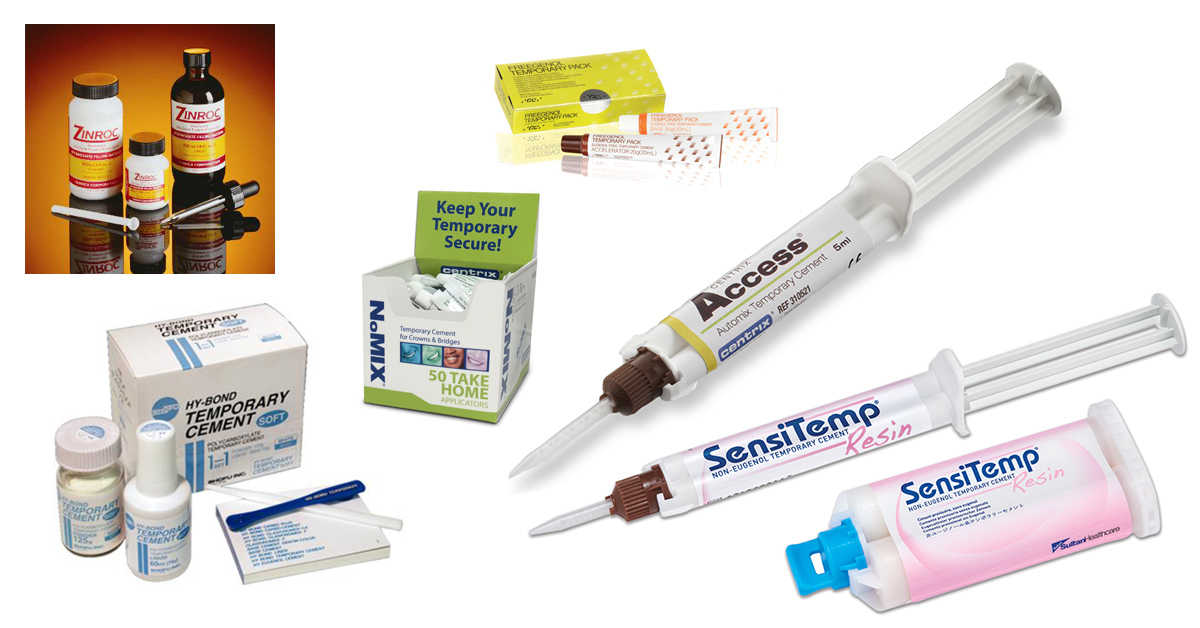Which Cement Is Most Commonly Used With Provisional Crowns
Which provisional preformed crowns are used on anterior teeth when appearance is important. Dental Materials Glass Ionomers.

Temporary Dental Cement Solutions Six Unique Products That Save Time Money And Space Blog
The most common type of provisional coverage used for crown and bridge preparations is _____.

. In a recent study of over 60 US dental schools resin modified glass ionomer was found to be the most commonly used and taught cement for implant crown cementation. What is the most commonly used cement for provisional crowns. Common uses include temporary restoration of teeth cavity linings to provide pulpal protection sedation or insulation and cementing fixed prosthodontic appliances.
Id like to sue the least retentive cement that keeps the implant crown in and does not necessitate frequent visits to recement. Which cement is most commonly used with provisional coverage. A clinician may use a different provisional cement for certain circumstances to achieve easier removal of the restoration at a later time compared to the need for a more rigid provisional cement that will allow for better retention on a crown preparation that is not retentive due to its occlusogingival height or the presence of excess taper to the axial walls of the crown.
A type of provisional that uses a polymer shell filled with a hybrid composite resin material that bonds with the preformed crown and tooth. Provisional Cements Creamy mix of zinc oxide eugenol Most practitioners use proprietary cements such as Temp Bond Available with modifier to soften the cement Non-eugenol Tem Bond is available and used to. What type of crown is used.
Which cement is most commonly used with provisional crowns. The newest form of temporary cements in dentistry is glass ionomer. Recent uses of dental cement also include two-photon calcium imaging of neuronal activity in brains of animal models in basic experimental.
In dentistry temporary cements are used to temporarily bond provisional restorations which include inlays onlays crowns bridges and implants. Most commonly used material for provisional restorations but for restorations of three units or more assistant-made PMMA shells lined intraorally with PEMA to provide more strength. In dentistry temporary cements are used to temporarily bond provisional restorations which include inlays onlays crowns bridges and implantsWhile there are numerous types of temporary cements the most common types are eugenol-based non-eugenol based and resin based.
What type of temporary cement is most commonly used on a provisional temporary. In the process of provisional restorations and root canal obturation zinc oxide eugenol is commonly used. Polycarbonate Which provisional uses a polymer shell filled with a hybrid composite resin that bonds with the preformed crown and tooth.
The crowns were luted with Tempbond Tempbond NE and Freegenol temporary cements and also with SnF2. YOU MIGHT ALSO LIKE. While there are numerous types of temporary cements the most common types are eugenol-based non-eugenol based and resin based.
Used in cases in which appearance is important. A provisional crown or bridge is not a permanent restoration. In dentistry temporary cements are used to temporarily bond provisional restorations which include inlays onlays crowns bridges and implants.
Dental cements have a wide range of dental and orthodontic applications. Provisional crowns are commonly cemented with _____ cement. Why make temporary crowns in lab.
Introduction of new materials for this type of restoration always call for extensive scientific evaluations to find the best and most effective cement material and ensure long-term clinical results. Which cement is most commonly used with provisional crowns. How long does it take for powder and liquid to set.
The present review study attempted to summarize available data on cement selection in one of the most commonly used restorations in dental practices. While there are numerous types of temporary cements the most common types are eugenol-based non-eugenol based and resin based. The crown is made from a polycarbonate material and is customized in varying sizes for anterior teeth.
What Is The Cement That Dentists Use. In dentistry temporary cements are used to temporarily bond provisional restorations which include inlays onlays crowns bridges and implants. In addition to preparing crowns inlays onlays orthodontic appliances and partial dentures zinc phosphate is also used for making original cement.
Known as the original cement zinc phosphate is used for preparing crowns inlays onlays orthodontic appliances and partial dentures. While there are numerous types of temporary cements the most common types are eugenol-based non-eugenol based and resin based. Temporary Which procedure would require a patient to wear a provisional prosthesis for a longer period of time than is typical.
Provisional crowns were constructed of acrylic resin with shoulder preparations for 12 molars. So what cement should we use. This cement composition produces high compressive strength an acceptable film thickness and high tensile strength that makes it hard to beat.
Glass Ionomer Cement was selected as it is the most commonly used definitive cement. Which cement is most commonly used with provisional crowns. While there are numerous types of temporary cements the most common types are eugenol-based non-eugenol based and resin based.
In dentistry temporary cements are used to temporarily bond provisional restorations which include inlays onlays crowns bridges and implants. Cement temporary restorations for preparations for definitive adhesive restorations eg All ceramic veneers to avoid interference with bonding of.

A Fantastic New Temporary Cement Lee Ann Brady Dmd


Comments
Post a Comment